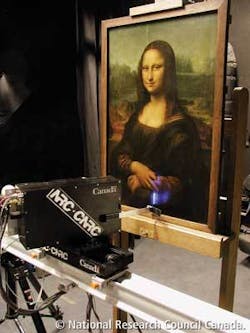3-D IMAGING: Laser-scanning project studies the Mona Lisa
In collaboration with the Centre de recherche et de restauration des musées de France (C2RMF; Paris, France), the National Research Council (NRC; Ottawa, Ontario, Canada) has completed a scientific study based on 3-D color laser scanning of Leonardo da Vinci’s portrait of the Mona Lisa.
On C2RMF’s request, seven researchers from the NRC traveled to Paris two years ago to scan the painting with NRC’s 3-D scanner, capable of scanning 3-D images at a depth resolution of 10 µm, which has subsequently provided a number of unique views of the portrait that will assist curators and conservators in their ongoing studies of the 500-year-old masterpiece.
The data, collected in 16 hours of scanning in 4 cm bands during two evenings in October of 2004, required more than a year of analysis. The 3-D model documented that the poplar wood panel on which da Vinci painted his masterwork has a convex warp on the middle right side that is 12 mm higher than its surroundings. It has provided the most detailed analysis to date of the network of surface cracks; the depth resolution was sufficient to see differences in the height around cracks. It also revealed “the incised drawing to provide us with Da Vinci’s general conception for the composition,” said Christian Lahanier, head of the Documentation Department of the C2RMF. The results of the research are contained in a new book Mona Lisa: Inside the Painting (Harry N. Abrams, publisher) and in an upcoming scientific text on the research.
“The 3-D scan of the Mona Lisa has not only helped to further our understanding of Leonardo’s sfumato technique of soft, heavily shaded modeling, but will also help to address the conservation and deterioration concerns we have,” said Henri Loyrette, director of the Musée du Louvre (Paris, France), which commissioned the study.
The NRC’s high-resolution 3-D color laser scanner has been used for scanning museum objects such as paintings, ethnographic and archaeological collections, and natural history specimens. The maximum resolution configuration of this scanner can record and examine fine brush-stroke details on paintings, as well as tool marks on sculptures and archaeological objects.
Simultaneous position and amplitude digitizing
One important feature of the auto-synchronized system in these applications is that relatively simple modifications can be made to enable simultaneous shape and color digitization. Because of the simultaneous position and amplitude digitizing of the three colors on the CCD image sensors, the shape (x, y, z) and red-green-blue (RGB) reflectance data are recorded in perfect registration.
The scanner uses red, green, and blue laser wavelengths as the laser source, which, when superimposed in the scanning system, results in the projection of a white, 50- to 100-µm-diameter laser spot on the object.
In the detector, a color-separation device such as a prism or a dispersive optical element positioned near the lens separates the white light reflected from the object, back into red, green, and blue wavelengths on the CCD detector. The amplitudes of the three peaks are converted into reflectance values for the three wavelengths by a calibration process that takes into account the geometry of illumination and detection at each surface element. Simultaneous position and amplitude digitizing of the three colors on the CCD results in perfect registration of (x, y, z) and RGB data.
For the Mona Lisa project, extensive modifications were made to allow portability of the laser-scanning system. The laser scanner head was mounted on a single-axis translation-stage gantry, which was mounted on a rigid pair of tripods (see figure). A total of 72 images was acquired of the painting, each image composed of 4000 profiles, and each profile containing 1024 coordinates of x, y, z, R, G, B shape and reflectance data, or the equivalent of 113 megapixels. To digitize the complete Mona Lisa, a series of successive scans or overlapping images were recorded over the complete surface of the object, observe, reverse, and for each side. The scans were subsequently merged to produce a final archival-quality 3-D digital model of the object.
The NRC 3-D technology, camera, and processing software have been licensed to nine Canadian companies. Among these, an Ottawa-based company has used the technology to create a 3-D camera currently onboard the NASA space shuttle Atlantis. The camera examines the changing state of the shuttle’s heat tiles during a voyage. Another licensee uses the technology for cutting-edge film animation, including the Lord of the Rings trilogy and the Matrix sequels.
